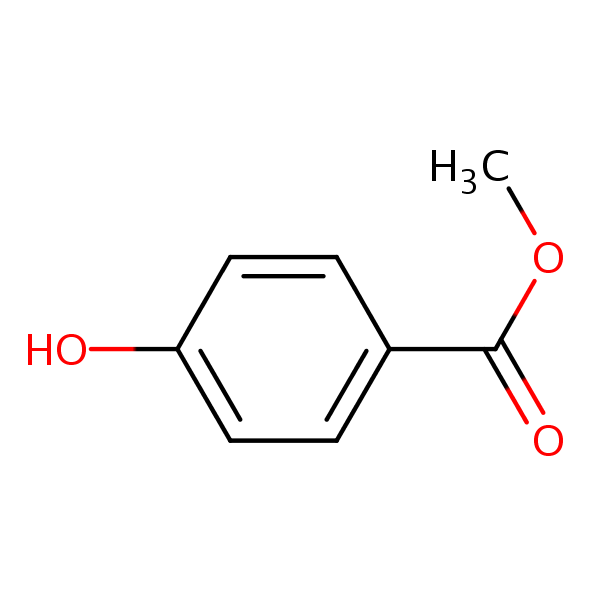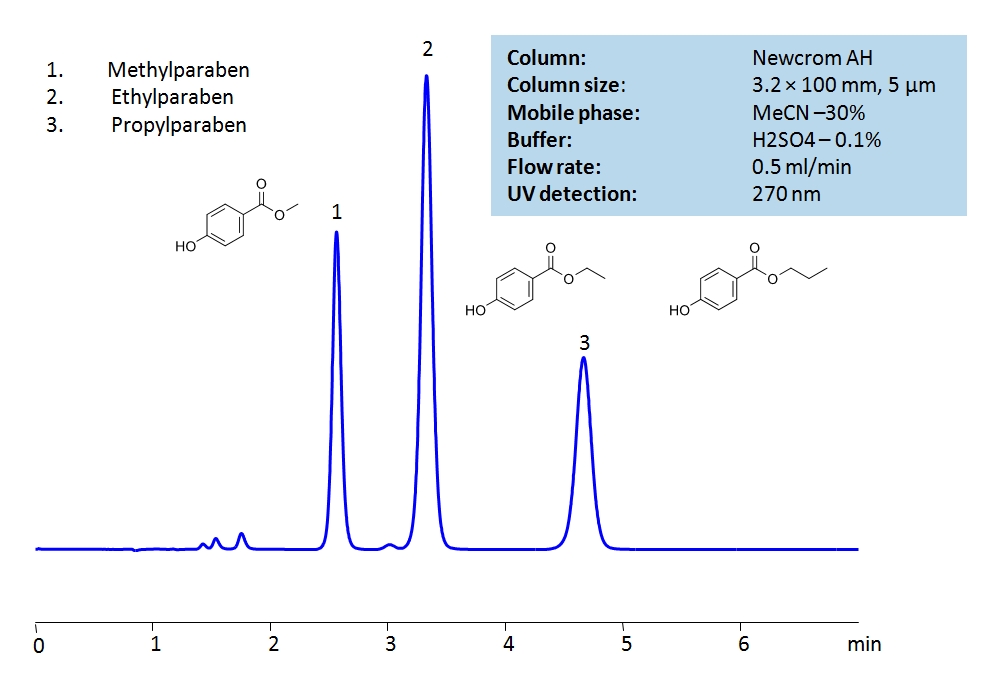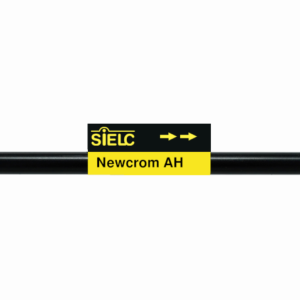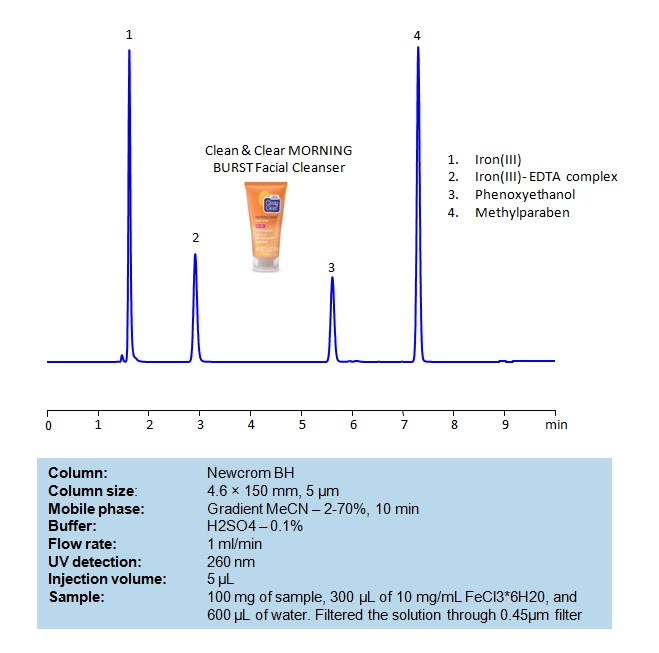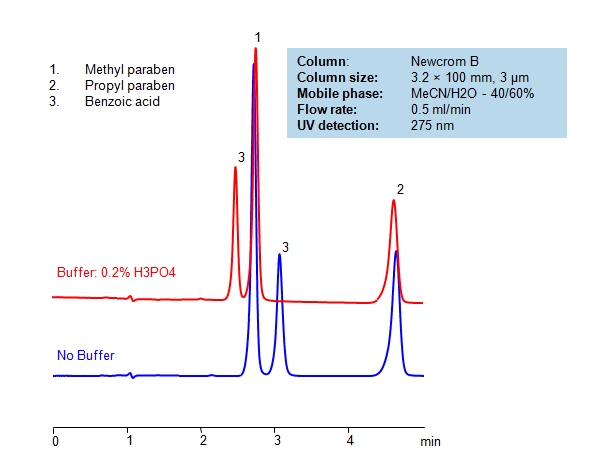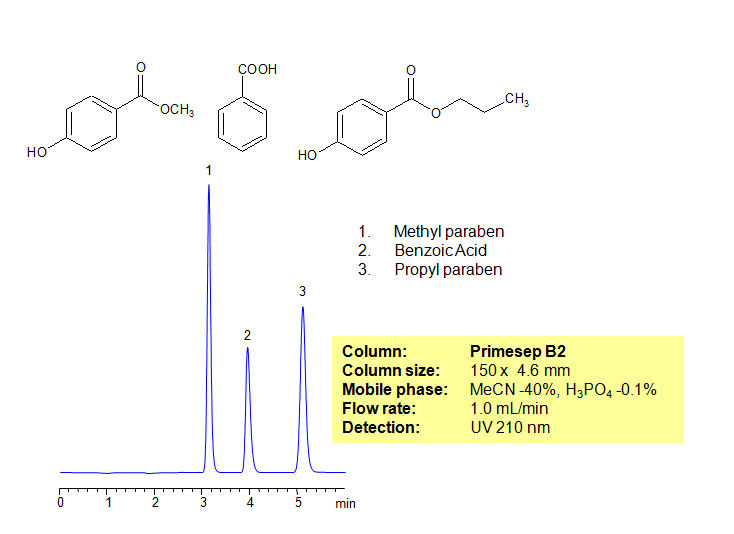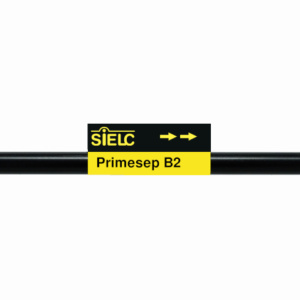| CAS Number | 99-76-3 |
|---|---|
| Molecular Formula | C8H8O3 |
| Molecular Weight | 152.150 |
| InChI Key | LXCFILQKKLGQFO-UHFFFAOYSA-N |
| LogP | 1.96 |
| Synonyms |
|
Applications:
HPLC Analysis of Paraben Preservatives on Newcrom AH Column
October 29, 2020
| Column | Newcrom AH, 3.2×100 mm, 5 µm, 100A |
| Mobile Phase | MeCN/H2O – 30/70% |
| Buffer | H2SO4 – 0.1% |
| Flow Rate | 0.5 ml/min |
| Detection | UV, 270 nm |
| Class of Compounds |
Preservatives, Hydrophobic |
| Analyzing Compounds | Methyl Paraben, Ethyl Paraben, Propyl Paraben |
Application Column
Newcrom AH
The Newcrom columns are a family of reverse-phase-based columns. Newcrom A, AH, B, and BH are all mixed-mode columns with either positive or negative ion-pairing groups attached to either short (25 Å) or long (100 Å) ligand chains. Newcrom R1 is a special reverse-phase column with low silanol activity.
Select optionsMethylparaben
Methylparaben sodium
Parabens
Propylparaben
Propylparaben sodium

HPLC Determination of EDTA, Phenoxyethanol and Methylparaben in Facial Cleanser on Newcrom BH
August 25, 2020
| Column | Newcrom BH, 4.6×150 mm, 100A |
| Mobile Phase | Gradient MeCN – 2- 70%, 10 min |
| Buffer | H2SO4 – 0.1% |
| Flow Rate | 1.0 ml/min |
| Detection | UV 260nm |
| Class of Compounds | Acid, Hydrophilic, Preservatives |
| Analyzing Compounds | EDTA, Methylparaben, Phenoxyethanol |
Application Column
Newcrom BH
The Newcrom columns are a family of reverse-phase-based columns. Newcrom A, AH, B, and BH are all mixed-mode columns with either positive or negative ion-pairing groups attached to either short (25 Å) or long (100 Å) ligand chains. Newcrom R1 is a special reverse-phase column with low silanol activity.
Select optionsEDTA (Ethylenediaminetetraacetic Acid)
Methylparaben
Methylparaben sodium

HPLC Separation of Mixture of Carbocisteine, Methylparaben & Propylparaben on Primesep 100 Column
July 31, 2019
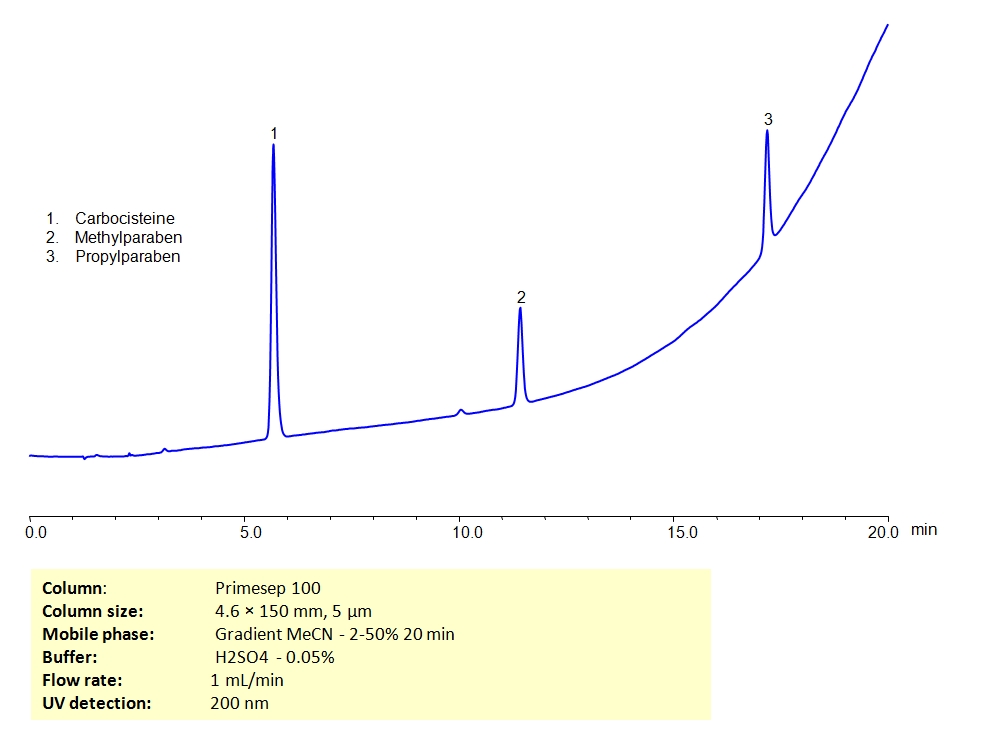
Carbocysteine is a medication that reduces the viscosity of mucus making it easier to cough up. Methylparaben and propylparaben are used as preservatives in cosmetics, pharmaceuticals and food. They can be separated in HPLC on a Primesep 100 mixed-mode column by both hydrophobic and ionic properties present on the stationary phase. The analytical method uses acetonitrile (ACN) gradient and water with sulfuric acid (H2SO4) as buffer and UV detected at 200nm.
| Column | Primesep 100, 4.6×150 mm, 5 µm, 100A |
| Mobile Phase | Gradient MeCN – 2-50%, 20 min |
| Buffer | H2SO4 – 0.05 % |
| Flow Rate | 1.0 ml/min |
| Detection | UV, 200 nm |
| Class of Compounds |
Drug, Acid, Hydrophilic, Ionizable, Carboxylic acid, Carbocyclic, Benzoate, Hydroxy Acid, Amino Acid, Hydroxybenzoate, Phenol |
| Analyzing Compounds | Carbocisteine, Methylparaben, Propylparaben |
Application Column
Primesep 100
The Primesep family of mixed-mode columns offers a wide variety of stationary phases, boasting unprecedented selectivity in the separation of a broad array of chemical compounds across multiple applications. Corresponding Primesep guard columns, available with all stationary phases, do not require holders. SIELC provides a method development service available to all customers. Inquire about our specially-tailored custom LC-phases for specific separations.
Select optionsMethylparaben
Methylparaben sodium
Propylparaben
Propylparaben sodium

Generic Screening Method for Complex Mixtures on Primesep 200
October 15, 2015
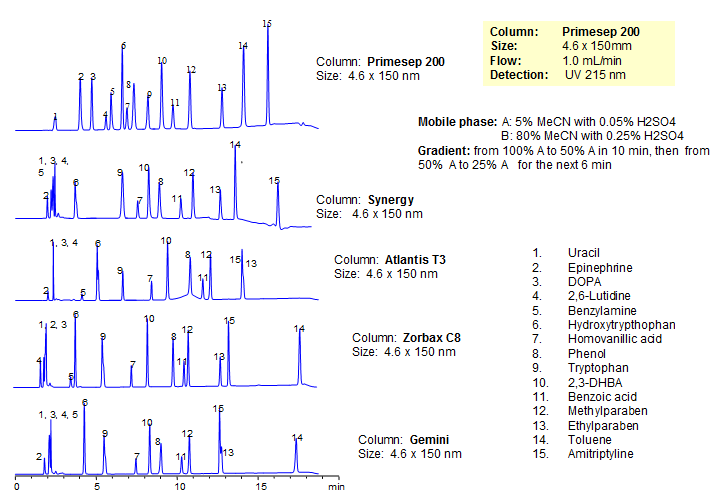
| Column | Primesep 200, 4.6*150 mm 5 µm, 100A |
| Mobile Phase | MeCN/H2O |
| Buffer | H2SO4 |
| Flow Rate | 1.0 ml/min |
| Detection | UV, 215 nm |
| Class of Compounds |
Drug, Acid, Hydrophilic, Ionizable, Hormone |
| Analyzing Compounds | Uracil, Epinephrine, DOPA, 2,6-Lutidine, Benzylamine, Hydroxytrypthophan, Homovanillic acid, Phenol, Tryptophan , 2,3-DHBA, Benzoic acid, Methylparaben, Ethylparaben, Toluene, Amitriptyline |
Application Column
Primesep 200
Column Diameter: 4.6 mm
Column Length: 150 mm
Particle Size: 5 µm
Pore Size: 100 A
2,6-Lutidine
Amitriptyline
Benzoic Acid
Benzylamine
DOPA (3,4-dihydroxy-L-phenylalanine)
Epinephrine
Ethylparaben
Homovanillic Acid
Hydroxytryptophan
Methylparaben
Phenol
Toluene
Tryptophan
Uracil

Analysis of Codeine-based Drug Composition. Effect of Buffer Concentration and Buffer PH
July 3, 2013
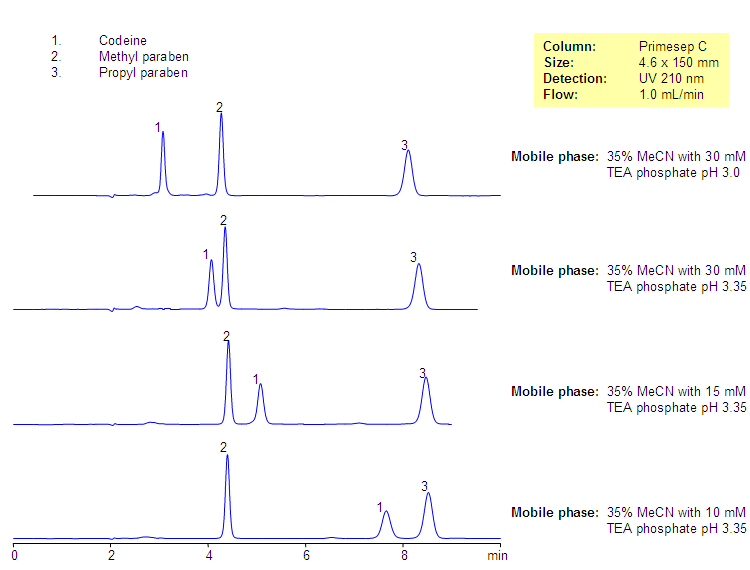
| Column | Primesep C, 4.6×150 mm, 5 µm, 100A |
| Mobile Phase | MeCN/H2O – 35/65% |
| Buffer | TEAPh Ph 3.5 – 15 Mm |
| Flow Rate | 1.0 ml/min |
| Detection | UV, 210 nm |
| Class of Compounds |
Drug, Preservatives, Base, Hydrophobic, Ionizable |
| Analyzing Compounds | Codeine, Methyl Paraben, Propyl Paraben |
Application Column
Primesep C
The Primesep family of mixed-mode columns offers a wide variety of stationary phases, boasting unprecedented selectivity in the separation of a broad array of chemical compounds across multiple applications. Corresponding Primesep guard columns, available with all stationary phases, do not require holders. SIELC provides a method development service available to all customers. Inquire about our specially-tailored custom LC-phases for specific separations.
Select optionsMethylparaben
Propylparaben

Analysis of Codeine and Related Impurities in Drug Composition
July 3, 2013
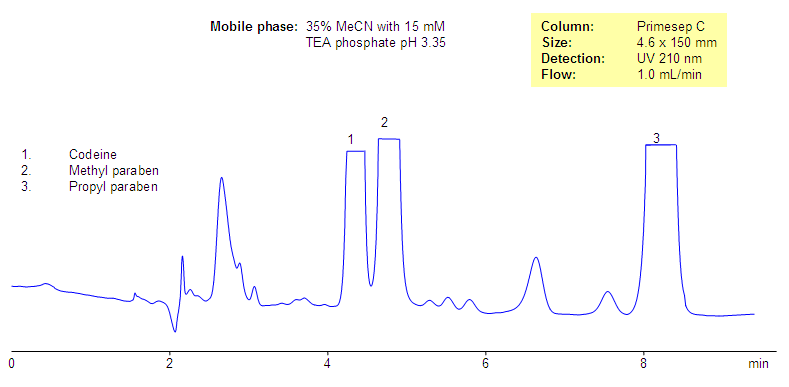
| Column | Primesep C, 4.6×150 mm, 5 µm, 100A |
| Mobile Phase | MeCN/H2O – 35/65% |
| Buffer | TEAPh Ph 3.5 – 15 Mm |
| Flow Rate | 1.0 ml/min |
| Detection | UV, 210 nm |
| Class of Compounds |
Drug, Preservatives, Base, Hydrophobic, Ionizable |
| Analyzing Compounds | Codeine, Methyl Paraben, Propyl Paraben |
Application Column
Primesep C
The Primesep family of mixed-mode columns offers a wide variety of stationary phases, boasting unprecedented selectivity in the separation of a broad array of chemical compounds across multiple applications. Corresponding Primesep guard columns, available with all stationary phases, do not require holders. SIELC provides a method development service available to all customers. Inquire about our specially-tailored custom LC-phases for specific separations.
Select optionsMethylparaben
Propylparaben

Analysis of Dextromethorphan-Based Composition
July 3, 2013
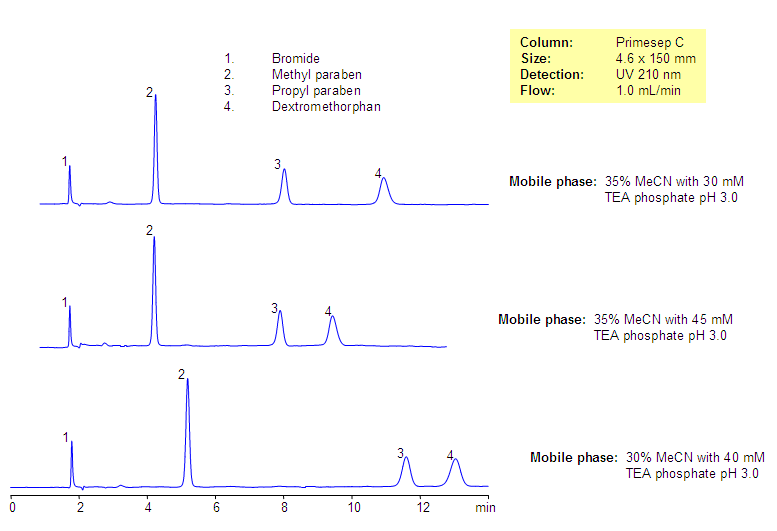
| Column | Primesep C, 4.6×150 mm, 5 µm, 100A |
| Mobile Phase | MeCN/H2O |
| Buffer | TEAPh |
| Flow Rate | 1.0 ml/min |
| Detection | UV, 210 nm |
| Class of Compounds |
Drug, Preservatives, Base, Hydrophobic, Ionizable |
| Analyzing Compounds | Dextromethorphan, Bromide, Methyl Paraben, Propyl Paraben |
Application Column
Primesep C
The Primesep family of mixed-mode columns offers a wide variety of stationary phases, boasting unprecedented selectivity in the separation of a broad array of chemical compounds across multiple applications. Corresponding Primesep guard columns, available with all stationary phases, do not require holders. SIELC provides a method development service available to all customers. Inquire about our specially-tailored custom LC-phases for specific separations.
Select optionsDextromethorphan
Methylparaben
Propylparaben

Analysis of Dextromethorphan-Based Drug composition. Effect on buffer pH
July 3, 2013
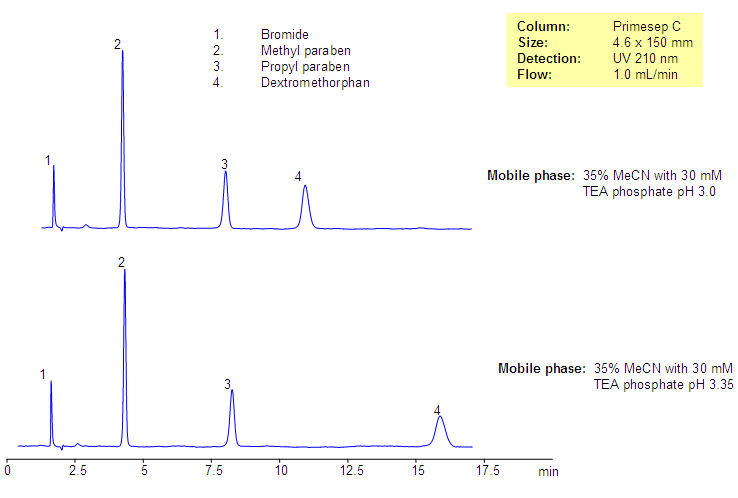
Dextromethorphan is one of the common cough suppressants used in many drug composition. It is in tablets and syrups as an antitussive drug. Composition often has preservatives like parabens. Dextromethorphan is a hydrophobic, basic drug which is used as a bromide salt in drug compositions. Dextromethorphan and two parabens (methyl paraben and propyl paraben) were separated on Primesep C reversed-phase cation-exchange column. Several impurities were observed and are well separated from the main components of the drug composition. Method can be used for various formulations in QC and production environment.
| Column | Primesep C, 4.6×150 mm, 5 µm, 100A |
| Mobile Phase | MeCN/H2O – 35/65% |
| Buffer | TEAPh |
| Flow Rate | 1.0 ml/min |
| Detection | UV, 210 nm |
| Class of Compounds |
Drug, Preservatives, Base, Hydrophobic, Ionizable |
| Analyzing Compounds | Dextromethorphan, Bromide, Methyl Paraben, Propyl Paraben |
Application Column
Primesep C
The Primesep family of mixed-mode columns offers a wide variety of stationary phases, boasting unprecedented selectivity in the separation of a broad array of chemical compounds across multiple applications. Corresponding Primesep guard columns, available with all stationary phases, do not require holders. SIELC provides a method development service available to all customers. Inquire about our specially-tailored custom LC-phases for specific separations.
Select optionsDextromethorphan
Methylparaben
Propylparaben

Analysis of Codeine-Based Drug Composition. Effect of Buffer Concentration and Buffer pH
July 2, 2013
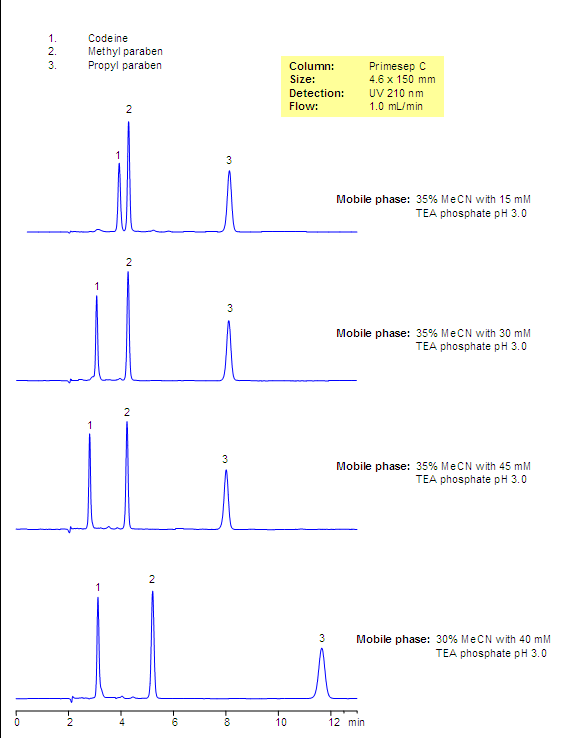
Codeine and two parabens are separated by mixed-mode chromatography. Codeine is retained by reversed-phase and cation-exchange mechanisms and parabens are retained by reversed-phase mechanism. The retention time of codeine can be adjusted by changing the amount of acetonitrile, buffer concentration, and buffer pH. The mobile phase for this column and its separation are fully compatible with UV, ELSD, LC/MS and prep chromatography, various organic and inorganic acids, and corresponding buffers can be used.

Codeine is a hydrophobic basic drug which is used in many drug compositions as an analgetic, antitussive, anxiolytic, and sedative agent. Codeine is widely used as a moderate pain and cough reliever. It is usually part of complex composition and comes in the form of a tablet or syrup. Several preservatives are used in most of the drug composition and include parabens and benzoates. The mixture of codeine, methyl and propyl parabens was separated on Primesep C mixed-mode reversed-phase cation-exchange column. Codeine is retained by reversed-phase and cation-exchange mechanisms and parabens are retained by reversed-phase mechanism. No ion-pairing reagent is required since Primesep C mixed-mode stationary phase has an ion-pairing reagent attached to the surface.
Application Column
Primesep C
The Primesep family of mixed-mode columns offers a wide variety of stationary phases, boasting unprecedented selectivity in the separation of a broad array of chemical compounds across multiple applications. Corresponding Primesep guard columns, available with all stationary phases, do not require holders. SIELC provides a method development service available to all customers. Inquire about our specially-tailored custom LC-phases for specific separations.
Select optionsMethylparaben
Propylparaben

HPLC Analysis of Active Drug and Amino Acids in a Formulation
October 14, 2010
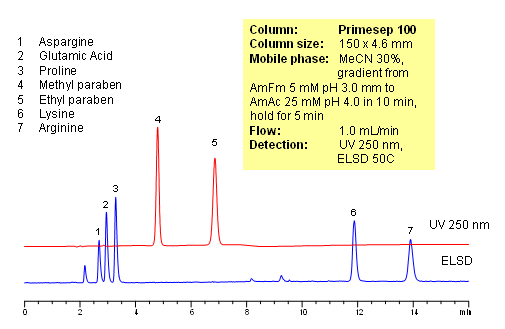
Polar amino acids are very often used as components of vitamin and supplement composition. Analysis of such complex composition is a challenging task. In this application, 5 amino acids (asparagine, glutamic acid, proline and arginine) and two preservatives (methyl paraben and propyl paraben) are separated on a Primesep 100 reversed-phase cation-exchange column with LC/MS compatible mobile phase. Method does not require ion-pairing reagent in the mobile phase. Compounds are monitored by ELSD and UV. Method is validated for quantitation of underivatized amino acids in complex mixtures. The method is simple and robust and can be used for analysis of various vitamin formulations.
| Column | Primesep 100, 4.6×150 mm, 5 µm, 100A |
| Mobile Phase | MeCN/H2O |
| Buffer | AmFm |
| Flow Rate | 1.0 ml/min |
| Detection | ELSD 50C, UV 250 nm |
| Class of Compounds |
Drug, Acid, Hydrophilic, Ionizable, Vitamin, Supplements |
| Analyzing Compounds | Glutamic acid, Aspargine, Proline, Lysine, Arginine, Methyl paraben, Propyl paraben |
Application Column
Primesep 100
The Primesep family of mixed-mode columns offers a wide variety of stationary phases, boasting unprecedented selectivity in the separation of a broad array of chemical compounds across multiple applications. Corresponding Primesep guard columns, available with all stationary phases, do not require holders. SIELC provides a method development service available to all customers. Inquire about our specially-tailored custom LC-phases for specific separations.
Select optionsAsparagine
Ethylparaben
Glutamic Acid
Lysine
Methylparaben
Proline
UV Detection

HPLC Separation of Methyl Paraben, Benzonitrile, Propyl Paraben, and Toluene on Mixed-Mode and Reverse Phase Columns
October 4, 2010
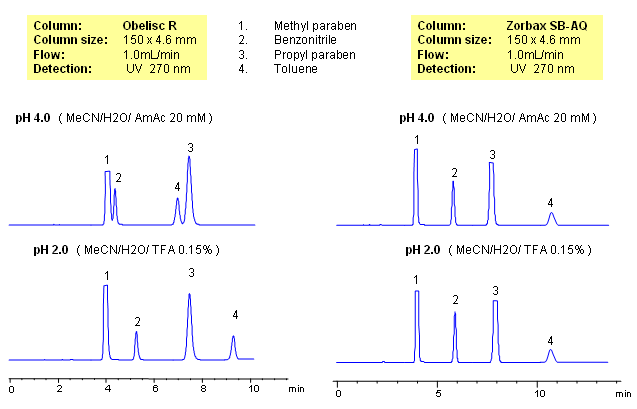
Parabens are common preservatives in pharmaceutical and cosmetic industries. They are esters of p-hydroxybenzoic acid. Method for separation of methyl paraben, propyl paraben, benzonitrile and toluene was developed on a Obelisc R column. All four compounds are neutral and are retained by reverse-phase mechanism. In case of reversed-phase stationary phase, no effect of pH is observed. Retention time for all four compounds changes on an Obelisc R column when pH is changed. pH of the mobile phase affects ionization state of stationary phase. Obelisc R column has C12 carbon chain and carboxylic acid with pKa of 4. At lower pH (pH 2, TFA), carboxylic acid of stationary phase is not ionized and thus adds hydrophobicity to stationary phase. Obelisc R column can be used for analysis of basic, acidic and neutral compounds with suitable detection techniques – UV, ELSD, CAD, LC/MS.
| Column | Obelisc R, 4.6×150 mm, 5 µm, 100A |
| Mobile Phase | MeCN/H2O |
| Buffer | AmAc, TFA |
| Flow Rate | 1.0 ml/min |
| Detection | UV, 270 nm |
| Class of Compounds |
Preservatives, Neutral |
| Analyzing Compounds | Methylparaben, Benzonitrile, Propyl paraben, Toluene |
Application Column
Obelisc R
SIELC has developed the Obelisc™ columns, which are mixed-mode and utilize Liquid Separation Cell technology (LiSC™). These cost-effective columns are the first of their kind to be commercially available and can replace multiple HPLC columns, including reversed-phase (RP), AQ-type reversed-phase, polar-embedded group RP columns, normal-phase, cation-exchange, anion-exchange, ion-exclusion, and HILIC (Hydrophilic Interaction Liquid Chromatography) columns. By controlling just three orthogonal method parameters - buffer concentration, buffer pH, and organic modifier concentration - users can adjust the column properties with pinpoint precision to separate complex mixtures.
Select optionsMethylparaben
Propylparaben
Toluene

HPLC Separation of Parabens and Benzoic Acid
June 5, 2006
| Column | Newcrom B, 3.2×100 mm, 3 µm, 100A |
| Mobile Phase | MeCN/H2O – 40/60% |
| Buffer | |
| Flow Rate | 0.5 ml/min |
| Detection | UV 275nm |
Parabens possess antibacterial and antifungal properties and are therefore widely used in pharmaceutical and cosmetic industries as preservatives in products. Parabens and benzoic acid can be baseline separated in a short time frame using Primesep B2 reverse-phase HPLC column with a simple mobile phase of water, acetonitrile (ACN, MeCN) and phosphoric acid of 0.1% as buffer. UV detection at 210nm.
| Column | Primesep B2, 4.6×150 mm, 5 µm, 100A |
| Mobile Phase | MeCN/H2O |
| Buffer | H3PO4 |
| Flow Rate | 1.0 ml/min |
| Detection | UV, 210 nm |
| Class of Compounds |
Acid, Hydrophilic, Preservative |
| Analyzing Compounds | Methyl paraben, Benzoic Acid, Propyl paraben |
Application Column
Newcrom B
The Newcrom columns are a family of reverse-phase-based columns. Newcrom A, AH, B, and BH are all mixed-mode columns with either positive or negative ion-pairing groups attached to either short (25 Å) or long (100 Å) ligand chains. Newcrom R1 is a special reverse-phase column with low silanol activity.
Select optionsPrimesep B2
The Primesep family of mixed-mode columns offers a wide variety of stationary phases, boasting unprecedented selectivity in the separation of a broad array of chemical compounds across multiple applications. Corresponding Primesep guard columns, available with all stationary phases, do not require holders. SIELC provides a method development service available to all customers. Inquire about our specially-tailored custom LC-phases for specific separations.
Select optionsMethylparaben
Parabens
Propylparaben

